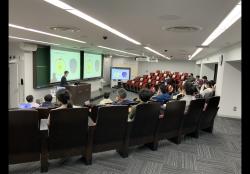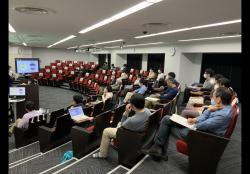The IMI Colloquium Report in April 13, 2022
2022.05.17
The IMI Colloquium in April was held on April 13, 2022.
The IMI Colloquium in April
Title: Let’s discover the connection between brain and mathematics
Speaker: OKAMOTO, Tsuyoshi (Faculty of Arts and Science, Kyushu University)
Place: IMI Auditorium (W1-D-413) and live-streaming by Zoom
Attendance: 63 (Students: 36; Staffs: 21; Others: 6)
First, by following his experiences, Professor Okamoto introduced collaborations between the industry and the academia, especially what does the industry require to the academia and what should the academia require to the industry. Because the collaboration with the industry plays one of key activities for IMI, we have obtained valuable information from his talk.
Next, while asking the participants what parts of the brain are important for mathematicians, he explained the basic matters of the brain, such as the roles of each part of the brain both from a macroscopic viewpoint and from microscopic one and the brain waves as the oscillation of neurons in the brain. At that time, he indicated that bifurcation analysis on differential equations yields the behavior of a single neuron governed by a mathematical model such as the Hodgkin–Huxley model. However, in order to understand the phenomena of actual brains, he complained the importances to understand the network of millions and billions of neurons and the behaiver of them.
Moreover, he brought up some problems to understand the brain, for example, using the motion of a blue blackboard eraser as “Binding problem”: how visual information is transmitted in two separate pathways in the brain, and how the information is grasped as a single object. Based on these problem consciousness, he explained about “Ishiki no Za (Origin of Consciousness) – Who is watching?”
Finally, he introduced the statistical processing of his recent experiments. For example, when studying the effect of bonfires, there exist various physical data such as the temperature, the humidity, and the wind velocity, subjective evaluation by experimental participants, and the spatial and temporal patterns of the brain waves observed during the experiment. Therefore, he has to find nonparametric tests applicable to repeated measures analysis of variance for more than two factors, has to avoid Type II error caused to repeat tests and to correct them, has to find multivariate analysis methods for simultaneous measurement data, and has to solve other problems. This facts indicate the possibility of the connection between the brain and the mathematics or statistics.



